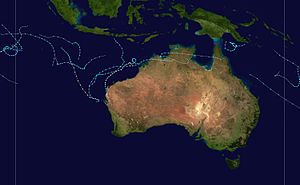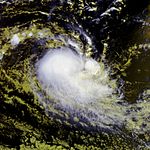2007–08 Australian region cyclone season
| 2007–08 Australian region cyclone season |

Season summary map
|
| Seasonal boundaries |
| First system formed |
29 July 2007 |
| Last system dissipated |
25 April 2008 |
| Strongest storm |
|
| Name |
Pancho |
| • Maximum winds |
175 km/h (110 mph)
(10-minute sustained) |
| • Lowest pressure |
934 hPa (mbar) |
| Seasonal statistics |
| Tropical lows |
14 |
| Tropical cyclones |
9 |
| Severe tropical cyclones |
3 |
| Total fatalities |
149 |
| Total damage |
$93.8 million (2008 USD) |
| Related articles |
|
|
Australian region tropical cyclone seasons
2005–06, 2006–07, 2007–08, 2008–09, 2009–10
|
| Category 1 tropical cyclone (Australian scale) |
| Tropical storm (SSHWS) |
|
|
| Duration |
29 July (entered basin) – 1 August |
| Peak intensity |
75 km/h (45 mph) (10-min) 992 hPa (mbar) |
| Category 2 tropical cyclone (Australian scale) |
| Tropical storm (SSHWS) |
|
|
| Duration |
13 November – 15 November |
| Peak intensity |
95 km/h (60 mph) (10-min) 984 hPa (mbar) |
| Category 3 severe tropical cyclone (Australian scale) |
| Category 1 tropical cyclone (SSHWS) |
|
|
| Duration |
13 November – 20 November |
| Peak intensity |
140 km/h (85 mph) (10-min) 970 hPa (mbar) |
| Tropical low (Australian scale) |
|
|
| Duration |
21 December – 22 December |
| Peak intensity |
55 km/h (35 mph) (10-min) 998 hPa (mbar) |
| Category 2 tropical cyclone (Australian scale) |
| Tropical storm (SSHWS) |
|
|
| Duration |
28 December – 2 January |
| Peak intensity |
110 km/h (70 mph) (10-min) 962 hPa (mbar) |
| Category 2 tropical cyclone (Australian scale) |
| Tropical storm (SSHWS) |
|
|
| Duration |
28 December – 6 January |
| Peak intensity |
95 km/h (60 mph) (10-min) 975 hPa (mbar) |
| Tropical low (Australian scale) |
|
|
| Duration |
31 December – 2 January |
| Peak intensity |
55 km/h (35 mph) (10-min) 994 hPa (mbar) |
| Tropical low (Australian scale) |
| Tropical storm (SSHWS) |
|
|
| Duration |
4 February – 10 February |
| Peak intensity |
55 km/h (35 mph) (10-min) 990 hPa (mbar) |
| Category 3 severe tropical cyclone (Australian scale) |
| Category 1 tropical cyclone (SSHWS) |
|
|
| Duration |
10 February – 20 February |
| Peak intensity |
150 km/h (90 mph) (10-min) 948 hPa (mbar) |
The 2007–08 Australian region cyclone season got off to an early start with the formation on 29 July of the first Tropical Cyclone which was not upgraded operationally to a cyclone but was later upgraded to a Cyclone during post storm analysis. This was the second time that a tropical Cyclone had formed during the month of July. The other one was Cyclone Lindsay in the 1996–1997 season. The next cyclone that formed was Cyclone Guba which formed on 13 November with TCWC Port Moresby assigning the name Guba on 14 November which was the first named storm within TCWC Port Moresby's area of responsibility since Cyclone Epi in June 2003. Guba was also the first cyclone to occur in the Queensland region in the month of November since 1977.
Tropical Cyclone Lee also formed on 13 November and was named by TCWC Perth on 14 November with it moving into RSMC Réunion's area of responsibility and being renamed Ariel. The next Cyclone to form within the Australian region was Melanie which formed on 27 December and was named on the 28th by TCWC Perth. Melanie was the first storm of the season which required Cyclone watches and warnings were issued for the Pilbara coast however it had weakened into a low pressure area before it made landfall.
Tropical Cyclone Helen was the first Tropical Cyclone to form in 2008 in the Southern Hemisphere which formed in TCWC Darwin's area of responsibility and was the first time that Darwin had experienced a tropical cyclone since Cyclone Gretel in the 1984–85 season. Cyclone Nicholas made landfall north of Carnarvon on 20 February as a category one cyclone. Cyclone Ophelia actually formed in TCWC Darwin's area of responsibility but had moved into TCWC Perth's area when it was named. Tropical Cyclone Pancho formed on 23 March south of Christmas Island and was named by TCWC Perth on 25 March and reached Category 4 status with winds of 95 kn (176 km/h).
In April 2008 Tropical Cyclones Rosie and Durga were the first ever Tropical Depressions to be monitored within TCWC Jakarta's area of responsibility and Durga was also the first storm to reach Tropical cyclone status and named whilst being monitored by TCWC Jakarta. Durga was also the last storm of the season which officially ended on 30 April.
...
Wikipedia


















